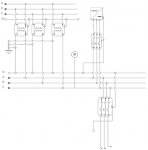PVfarmer
Senior Member
- Location
- Newport County, Rhode Island, USA
Dude, read what I said again. This time I'll bold the important parts for you.
1. "Both loads and interactive-inverters must connect to a system with the right voltage and configuration. Generally that system is either the utility service, ... or a separately derived system,"
2. In the next quote you talk about "a load running from L1 and L2 of the Tripowers". That's crazy talk. You connect the load to L1 and L2 of the system. You connect the Tripowers to L1,2,3 and N of the system. If you only connect a load to the Tripowers nothing will work.
3. As I said, there are limits on the size of imbalance. That is not the same as imbalance being prohibited.
4. To the grid. And/or somehow to another load connected to L3 directly or inductively through a transformer.
5. Getting 480V by not connecting to neutral does not mean neutral does not exist. Maybe if you had ever done any electrical work this wouldn't be so hard for you to understand.
1. Yes. But is it really either/or as far as utility/separately derived? You could connect to either just the utility, or utility *and* a separately derived, while you can't connect to separately derived only-
And when you are connecting output from PV inverter(s) to both utility and SD, those systems should logically be the same voltage.
2. The OP says "I figured 480 delta to 240 delta would work. I am wondering if i connect the A and C phase to a single phase panel and just leave the High leg out." 4
480 delta won't work, because the system is 480/277V wye, unless you go 480/277 wye to 480 delta and then (with a 2nd xfmr) 480 delta to XXXV like SMA says as a "fix" for LV delta on pages 6 and 7.
And connecting to A and C (or L1 and L2 as I said) to supply a load either won't work at all or isn't the best way to do it.
The OP would want to use A, B, C, and N (or L1, L2, L3, and N) for the load.
3. It sure isn't encouraged!
4. How about this- say the OP has just one Tripower, a 15000TL/15000 watt. Say the load is a 20hp irrigation pump instead of a welder and lights. 20hp= 14920 watts.
The OP could:
A- Use a 3 phase 480V irrigation pump. That would draw all 18 amps the 15000TL puts out at max. So when the 15000TL is running at 50%, the rest would come from the grid.
B- Use a 1 phase 240V pump, from L1 and L2 of grid/inverter into a 480V to 240V xfmr. That would draw 62.5 amps, but that isn't possible from 2 legs of the 15000TL- you only get 12A from 2 legs, which is 41.5 amps @ 240V.
A seems "workable" and B does not- with B, there would have to be current going both to and from the grid. That sounds wrong to me.
5. I do understand it- the neutral still has to go somewhere, which is to ground. I just don't think to ground qualifies as "leading out"...




